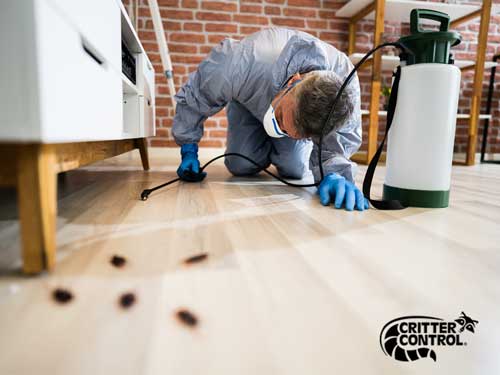Trusted A1 Exterminator Charlotte NC - Comprehensive Pest Solutions
Wiki Article
Bed Bug Treatment Break Down: Comparing Chemical Vs. Non-Chemical Solutions
In the world of parasite control, especially when handling the consistent concern of bed bugs, the selection between chemical and non-chemical therapy services can be an essential one. Both approaches offer distinct advantages and drawbacks, influencing aspects such as performance, safety considerations, and general price. By taking a look at the nuanced details of each approach, a clearer understanding of which path to seek in attending to a bed bug invasion can be achieved.Efficiency of Chemical Treatments
Chemical treatments for bed bug invasions have been commonly recognized for their potent and rapid effectiveness in eradicating these pests. When thinking about the effectiveness of chemical therapies, it is vital to understand that they can give a fast and comprehensive service to a bed pest issue.Moreover, chemical therapies have the benefit of supplying recurring effects, meaning that they can remain to get rid of bed pests even after the preliminary application. This recurring action is particularly beneficial in combating any type of possible re-infestations. Additionally, the fast activity of chemical treatments can bring relief to individuals encountering severe bed insect infestations, permitting them to restore control of their home quickly.
Safety Worry About Chemical Solutions
One crucial facet that calls for cautious factor to consider when using chemical remedies for bed pest therapy is making certain the security of owners and the setting. Exposure to specific chemicals made use of in bed pest therapies can lead to breathing problems, skin irritation, or various other unfavorable responses, especially in individuals with pre-existing problems or level of sensitivities.Furthermore, the ecological impact of chemical options is another substantial consideration. Some chemicals made use of in bed insect therapies might be dangerous to useful bugs, wildlife, and ecological communities if they leach right into the dirt or water supply. It is vital to make use of chemical therapies judiciously, following security standards, and taking into consideration much less toxic alternatives to reduce these dangers and make sure the secure and effective monitoring of bed bug invasions.
Advantages of Non-Chemical Approaches
Considering the possible security concerns and ecological effect connected with chemical solutions for bed pest treatment, exploring non-chemical methods offers a promising choice with several unique benefits. Non-chemical treatments are environmentally pleasant, as they do not add to air or water contamination, making them a sustainable option for pest control.Furthermore, non-chemical remedies can be efficient in targeting bed insects, including hard-to-reach areas where chemical therapies might not penetrate - A1 exterminators charlotte nc. Approaches such as warmth therapy, vacuuming, vapor cleansing, and mattress coverings offer comprehensive eradication without the use of harmful chemicals.
Limitations of Non-Chemical Treatments

In addition, non-chemical therapies frequently need numerous applications to achieve successful removal. This can be lengthy and might not constantly guarantee total removal of all bed pests and their eggs, particularly in surprise or hard-to-reach places.
In addition, the success of non-chemical therapies heavily relies upon appropriate application and thoroughness, which can be testing for individuals without professional competence. Poor additional reading application of non-chemical techniques might lead to incomplete obliteration, resulting in persistent problems and the requirement for extra treatments.
Consequently, while non-chemical therapies have their benefits, it is vital to recognize these constraints and consider them when determining one of the most efficient approach for taking care of bed insect invasions.
Cost Comparison: Chemical Vs. Non-Chemical Options
Provided the limitations associated with non-chemical therapies, a crucial element to review in the context of bed pest administration is the expense contrast in between chemical and non-chemical options. Chemical treatments generally involve the application of pesticides by experts, which can range from $250 to $900 per area, depending that site upon the seriousness of the infestation and the dimension of the location to be treated. In contrast, non-chemical treatments like warm therapy or vapor can be much more costly, with expenses ranging from $1,000 to $6,000 for an entire home. While the first cost of chemical therapies might seem reduced, several treatments might be required to fully eradicate the infestation, potentially boosting the general cost. On the other hand, non-chemical options may supply hop over to here a much more environment-friendly and lasting service, although they can be cost-prohibitive for some people. Inevitably, when considering the cost of bed bug therapy alternatives, it is important to weigh the upfront expenses against the effectiveness and long-term sustainability of the selected approach.Final Thought

Thinking about the prospective security problems and environmental influence linked with chemical options for bed bug treatment, exploring non-chemical techniques presents an appealing alternative with several distinct benefits.Given the limitations associated with non-chemical treatments, an important facet to evaluate in the context of bed insect management is the price comparison in between chemical and non-chemical choices. In contrast, non-chemical therapies like warm treatment or vapor can be much more pricey, with costs ranging from $1,000 to $6,000 for a whole home. While the first expense of chemical therapies may appear reduced, multiple treatments may be called for to fully remove the infestation, potentially enhancing the overall cost.In final thought, when contrasting chemical and non-chemical bed bug therapy choices, it is necessary to consider efficiency, safety and security, benefits, limitations, and expense.
Report this wiki page